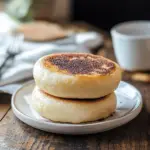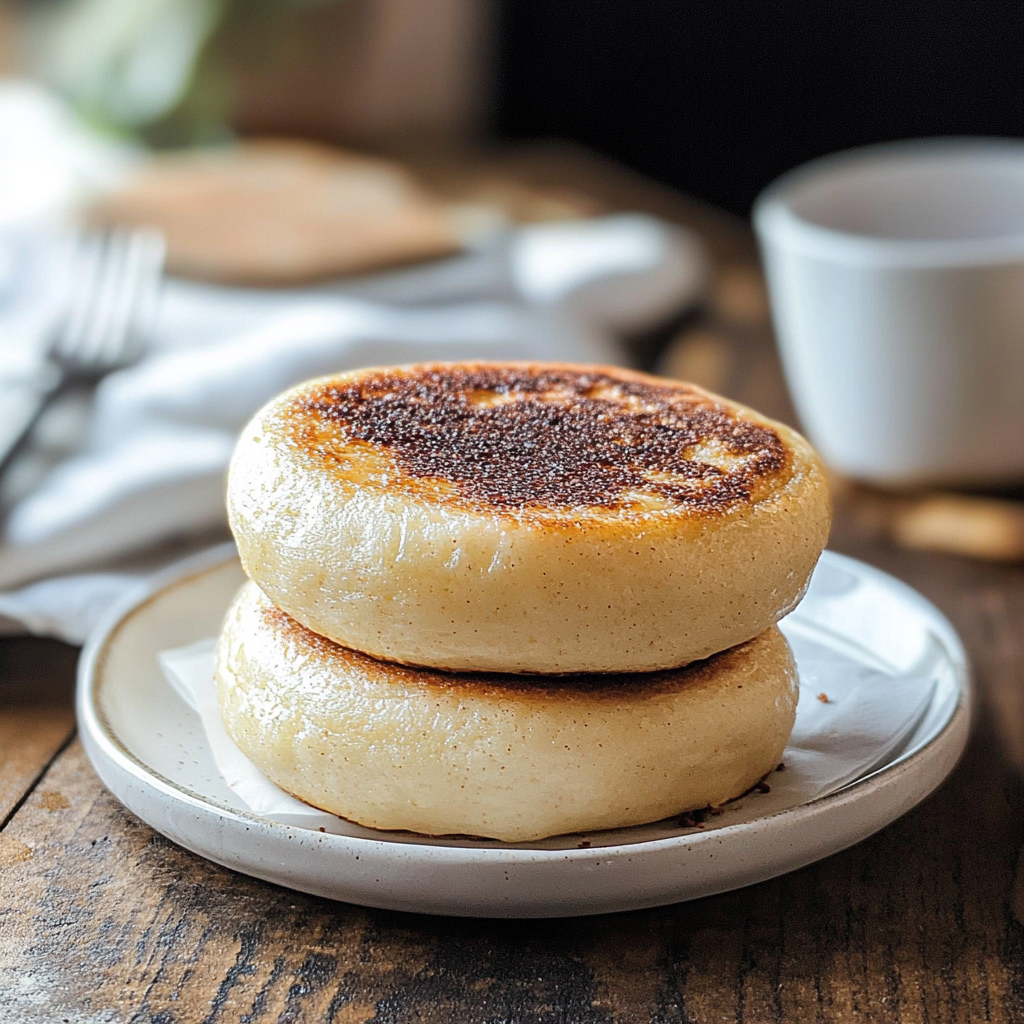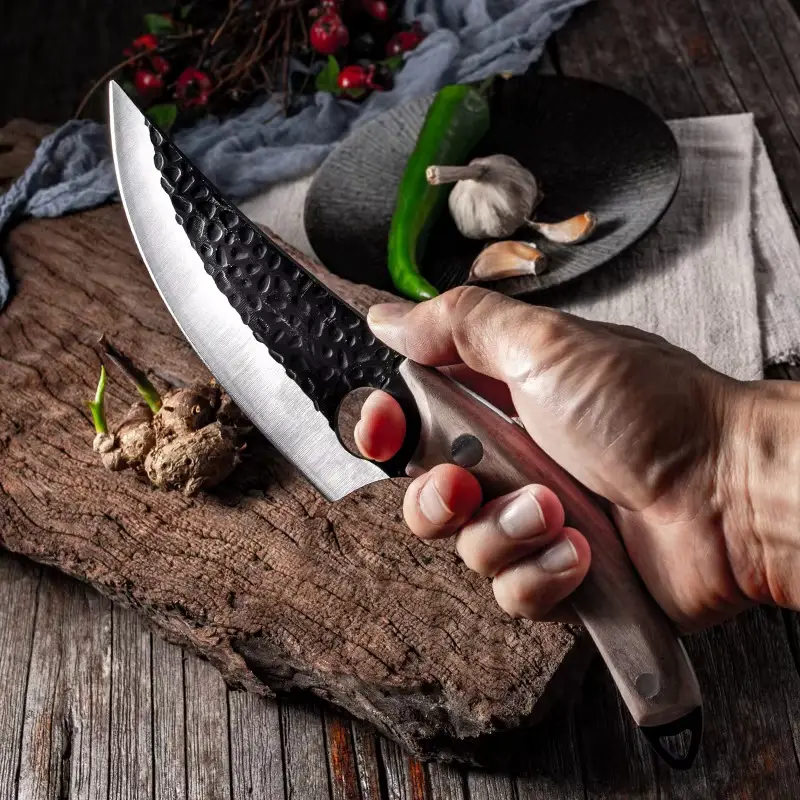Soft, chewy, and studded with signature nooks and crannies, English muffins are a beloved breakfast staple that pair perfectly with butter, jam, or eggs. These classic griddle-cooked breads are a versatile addition to any meal, easily transforming into sandwiches, mini pizzas, or the foundation for eggs Benedict. While store-bought versions are convenient, homemade English muffins boast superior flavor, texture, and freshness. This recipe provides step-by-step instructions to create your own batch of delicious, golden-brown muffins that are crispy on the outside and tender on the inside.
Why You’ll Love This Recipe
- Deliciously Fresh: Homemade English muffins are fresher and fluffier than store-bought varieties.
- Versatile: Use them for breakfast, lunch, snacks, or even desserts.
- Unique Cooking Method: Cooked on a griddle, these muffins have a rustic charm.
- Customizable: Easily adapt the recipe with whole wheat flour or flavor additions like cinnamon and raisins.
- Beginner-Friendly: Straightforward instructions make this recipe accessible for bakers of all levels.
Preparation Time and Servings
- Prep Time: 20 minutes
- Cook Time: 12 minutes per batch
- Rise Time: 1 hour 30 minutes
- Total Time: 2 hours 15 minutes
- Yield: 12 muffins
- Serving Size: 1 muffin
Nutritional Information (per serving)
- Calories: 180
- Carbohydrates: 30g
- Protein: 5g
- Fat: 3g
- Fiber: 2g
- Sugar: 2g
Ingredients
For the Dough:
- 3 ½ cups (440g) all-purpose flour
- 2 tsp granulated sugar
- 1 tsp salt
- 2 ¼ tsp (1 packet) active dry yeast or instant yeast
- 1 cup (240ml) warm milk (110°F or 43°C)
- ½ cup (120ml) warm water (110°F or 43°C)
- 3 tbsp unsalted butter, melted
For Cooking:
- ½ cup cornmeal (optional, for dusting)
- Butter or oil for greasing the griddle
Step-by-Step Instructions
1. Prepare the Dough
- In a small bowl, dissolve the yeast in warm water. Let it sit for 5 minutes until frothy. If using instant yeast, this step can be skipped.
- In a large mixing bowl, combine the flour, sugar, and salt. Mix well.
- Add the yeast mixture, warm milk, and melted butter to the dry ingredients. Stir until the dough comes together.
2. Knead the Dough
- Transfer the dough to a lightly floured surface and knead for 8–10 minutes, or until it becomes smooth and elastic. If using a stand mixer, knead with the dough hook attachment for about 5–6 minutes on medium speed.
- Shape the dough into a ball and place it in a greased bowl. Cover with a damp towel or plastic wrap and let it rise in a warm place for 1 hour, or until doubled in size.
3. Shape the Muffins
- Once the dough has risen, punch it down to release air. Turn it out onto a lightly floured surface.
- Roll the dough to about ½-inch thickness. Use a 3-inch round cutter or the rim of a glass to cut out circles. Re-roll the scraps to make additional muffins.
- Sprinkle a baking sheet with cornmeal and place the dough rounds on top. Lightly sprinkle more cornmeal over the tops. Cover loosely with a towel and let rise for another 30 minutes.
4. Cook the Muffins
- Heat a griddle or large skillet over low to medium-low heat and grease lightly with butter or oil.
- Place the dough rounds on the griddle and cook for 6–7 minutes on each side, or until golden brown. Adjust the heat to ensure the muffins cook through without burning.
- Transfer the cooked muffins to a wire rack to cool.
5. Serve and Enjoy
- Split the muffins with a fork to reveal their nooks and crannies. Toast and serve with butter, jam, or your favorite toppings.
Ingredient Background
- All-Purpose Flour: Provides structure and the perfect balance of chewiness and softness. Whole wheat flour can be used for a heartier version.
- Yeast: Creates the light and airy texture by helping the dough rise. Active dry yeast requires proofing, while instant yeast can be added directly to the flour.
- Milk: Adds moisture and richness to the dough. Whole milk works best, but low-fat or plant-based milk can be used.
- Butter: Enhances flavor and gives the muffins a tender crumb.
- Cornmeal: Optional, but adds texture and helps prevent sticking during cooking.
Technique Tips
- Use Warm Liquid: Ensure the milk and water are warm but not hot. This activates the yeast without killing it.
- Proper Kneading: Knead until the dough is smooth and elastic. This ensures the muffins will rise evenly and have a light texture.
- Low Heat Cooking: Cook the muffins on low to medium-low heat to prevent burning and ensure they cook through.
- Fork Splitting: Use a fork to split the muffins rather than a knife to maintain the characteristic nooks and crannies.
Alternative Presentation Ideas
- Mini English Muffins: Use a smaller cutter for bite-sized versions, perfect for appetizers or kids’ snacks.
- Whole Wheat Muffins: Replace half or all of the all-purpose flour with whole wheat flour for a nuttier flavor and added fiber.
- Sweet Muffins: Add 1 tsp of cinnamon and ¼ cup of raisins to the dough for a sweet breakfast treat.
- Stuffed Muffins: Before the second rise, place a small piece of cheese or cooked sausage in the center of each dough round and pinch the edges to seal.
Additional Tips for Success
- Test the Yeast: If the yeast doesn’t foam after 5 minutes of proofing, it may be expired. Start with fresh yeast.
- Prevent Sticking: Dust the work surface, cutter, and hands with flour to prevent the dough from sticking.
- Don’t Overheat the Pan: Too high heat will burn the outside before the inside is fully cooked.
- Store Properly: Keep muffins in an airtight container or freeze for longer storage. Toast before serving to refresh their texture.
Recipe Variations
- Sourdough English Muffins: Replace half the flour with sourdough starter for a tangy twist.
- Gluten-Free English Muffins: Use a gluten-free flour blend and adjust the liquid as needed for the right dough consistency.
- Cheesy Muffins: Mix ½ cup of shredded cheddar or Parmesan into the dough for a savory version.
- Herbed Muffins: Add 1 tbsp of chopped fresh herbs like rosemary, thyme, or parsley for added flavor.
Freezing and Storage
- Refrigeration: Store cooled muffins in an airtight container at room temperature for up to 3 days.
- Freezing: Slice muffins in half, wrap them individually in plastic wrap, and place them in a freezer-safe bag. Freeze for up to 3 months. To reheat, toast directly from frozen.
Healthier Twist Ideas
- Whole Grain Option: Use whole wheat flour for added fiber and nutrients.
- Low-Sodium: Reduce the salt to ½ tsp if you’re watching your sodium intake.
- Plant-Based: Substitute plant-based butter and milk to make the recipe vegan-friendly.
- Add Seeds: Sprinkle chia seeds, flaxseeds, or sunflower seeds on top of the muffins before cooking for extra nutrition.
Serving Suggestions for Events
- Breakfast Buffet: Serve with an assortment of jams, butter, and cream cheese.
- Brunch Sandwiches: Use English muffins as the base for sandwiches filled with eggs, avocado, and bacon.
- Afternoon Tea: Pair with tea and clotted cream for a British-inspired spread.
- Party Bites: Top mini muffins with smoked salmon and cream cheese for elegant hors d’oeuvres.
Special Equipment
- Round Cutter: A 3-inch cutter creates evenly sized muffins, but a glass can be used as a substitute.
- Griddle or Cast-Iron Skillet: Provides even heat distribution for consistent cooking.
- Wire Rack: Ensures proper cooling to maintain texture.
Frequently Asked Questions
Q1: Can I use whole wheat flour for the entire recipe?
Yes, but the texture will be denser. Start with a 50:50 ratio of whole wheat and all-purpose flour to maintain softness.
Q2: Why are my muffins dense?
Dense muffins can result from over-kneading, under-proofing, or using too much flour. Ensure the dough is soft and the muffins rise fully before cooking.
Q3: Do I need to bake them after cooking on the griddle?
No, griddle cooking is sufficient. Just ensure the muffins are cooked through by using low heat.
Q4: Can I make the dough ahead of time?
Yes, refrigerate the shaped dough rounds overnight, then bring to room temperature before cooking.
Q5: Can I use bread flour?
Yes, bread flour will give the muffins a slightly chewier texture.
Q6: Why don’t my muffins have nooks and crannies?
Over-kneading or slicing with a knife can reduce nooks and crannies. Use a light hand when kneading and a fork to split.
Q7: Can I make English muffins without yeast?
Yes, you can use baking powder or baking soda for a quick-bread version, though the flavor and texture will differ.
Q8: How do I toast English muffins perfectly?
Split the muffins with a fork, then toast cut-side down until golden brown.
Conclusion
Homemade English Muffins offer the perfect balance of rustic charm and versatile utility. Their chewy texture, golden crust, and signature nooks and crannies make them an irresistible addition to any meal. Whether topped with butter and jam, used as the foundation for a breakfast sandwich, or transformed into a gourmet appetizer, these muffins will elevate your culinary creations. With this detailed recipe, you’ll master the art of making English muffins and enjoy their superior taste and texture fresh from your kitchen!
Print
English Muffin
- Total Time: 2 hours 15 minutes
- Yield: 12 muffins 1x
Ingredients
For the Dough:
- 3 ½ cups (440g) all-purpose flour
- 2 tsp granulated sugar
- 1 tsp salt
- 2 ¼ tsp (1 packet) active dry yeast or instant yeast
- 1 cup (240ml) warm milk (110°F or 43°C)
- ½ cup (120ml) warm water (110°F or 43°C)
- 3 tbsp unsalted butter, melted
For Cooking:
- ½ cup cornmeal (optional, for dusting)
- Butter or oil for greasing the griddle
Instructions
Step-by-Step Instructions
1. Prepare the Dough
- In a small bowl, dissolve the yeast in warm water. Let it sit for 5 minutes until frothy. If using instant yeast, this step can be skipped.
- In a large mixing bowl, combine the flour, sugar, and salt. Mix well.
- Add the yeast mixture, warm milk, and melted butter to the dry ingredients. Stir until the dough comes together.
2. Knead the Dough
- Transfer the dough to a lightly floured surface and knead for 8–10 minutes, or until it becomes smooth and elastic. If using a stand mixer, knead with the dough hook attachment for about 5–6 minutes on medium speed.
- Shape the dough into a ball and place it in a greased bowl. Cover with a damp towel or plastic wrap and let it rise in a warm place for 1 hour, or until doubled in size.
3. Shape the Muffins
- Once the dough has risen, punch it down to release air. Turn it out onto a lightly floured surface.
- Roll the dough to about ½-inch thickness. Use a 3-inch round cutter or the rim of a glass to cut out circles. Re-roll the scraps to make additional muffins.
- Sprinkle a baking sheet with cornmeal and place the dough rounds on top. Lightly sprinkle more cornmeal over the tops. Cover loosely with a towel and let rise for another 30 minutes.
4. Cook the Muffins
- Heat a griddle or large skillet over low to medium-low heat and grease lightly with butter or oil.
- Place the dough rounds on the griddle and cook for 6–7 minutes on each side, or until golden brown. Adjust the heat to ensure the muffins cook through without burning.
- Transfer the cooked muffins to a wire rack to cool.
5. Serve and Enjoy
- Split the muffins with a fork to reveal their nooks and crannies. Toast and serve with butter, jam, or your favorite toppings.
- Prep Time: 20 minutes
- Rise Time: 1 hour 30 minutes
- Cook Time: 12 minutes
Nutrition
- Serving Size: 1 muffin
- Calories: 180
- Sugar: 2g
- Fat: 3g
- Carbohydrates: 30g
- Fiber: 2g
- Protein: 5g



